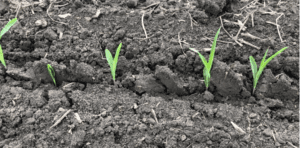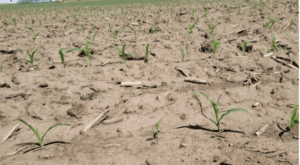By Jerry Hartsock & Dakota Miller
Cutting Edge Consulting & Research Services
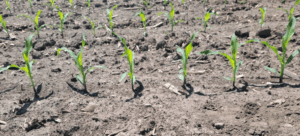
We have the working knowledge to take you to stands like this if your stands do not represent this already!
Stand establishment of corn and soybeans is the combined result of seed quality, planting standards, soil conditions at planting, weather patterns 24-48 hours after planting, and more. Evaluating stands involves determining two aspects: stand quantity (population) and stand quality (number of full ears at harvest compared to planting population). These two critical components cannot be determined by driving by at 45 mph. It requires in-field observations and data collection with the proper tools to measure, dig, calculate, etc. It is absolutely IMPERATIVE to have a plan, a motivated team behind you, and the right mindset every day to achieve excellence because excellence does not happen by luck or by chance. It is also important because it’s difficult to implement any change once the crop emerges. Replant is painful and costly!
At AgVenture we have a vast working knowledge that the start of corn is your one chance to do it at the highest standards. We prefer uniform emergence of every plant and good spacing between plants. An example of AgVenture planting standards is corn that is planted 2 ¼” deep consistently across the field at 4.5 mph planting speed to manage unit bounce (FYI – “high speed planters” work excellent at 4.5-5.0 mph). A warm, level and firm seed bed is preferred by these planters. These standards combined with what we believe is the best seed quality is the ONLY way to end up with an impressive and much more profitable stand of corn. At AgVenture we believe that seed quality should include the best warm AND cold germination scores along with low abnormals. We do rigid testing on all three seed quality components, because we want to know the quality and send only the best out the door! The above planting standards and seed quality coming together leads to a stand of corn like the one pictured below. A very uniform, consistent, and vigorous stand that shows a close proportion to the planting population and will show a close proportion of plants to final ears at the end of the season is what to expect when using AgVenture planting and seed quality standards.
The reason we are so driven on planting standards and seed quality is because we know that all decisions from emergence onward can and should be based on the quantity and quality of stand. We’ve developed a process we call Net Effective Plant Stand (NEPS) ratings as a tool to put a numerical value on a stand. This rating shows the number of full ears at harvest there will be compared to the planting population or spaces of opportunity that exists. We have a goal to achieve 90% and above N.E.P.S and we are never satisfied and are always looking to improve our score!
A N.E.P.S score lower than our standards is what we would expect in the below pictures for a multitude of reasons. The examples below are the results of either driving too fast (inconsistent planting depth), seed or germination scores not to our standards, field cultivator that brought up clods and mud that fluffed up the top four inches, or the planting process was not up to our standards (possibly too shallow of planting, or not running in fit conditions). In the pictures, you can see skips or gaps, as well as delayed emergers which will not be full-producing plants. Skips or gaps can be the result of the sub-par standards mentioned above. Delayed emergers can result from the same thing and only produce a partial ear when the stand count may make you think you will get mostly full producers. These delayed emergers could have stemmed from:
- Too shallow of planting
- Inconsistent planting depth
- Residue next to seed
- Weak seed
- Unsafe herbicides
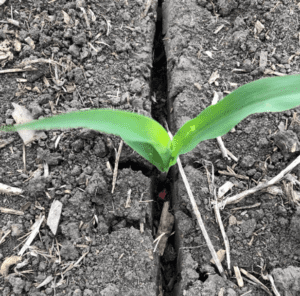
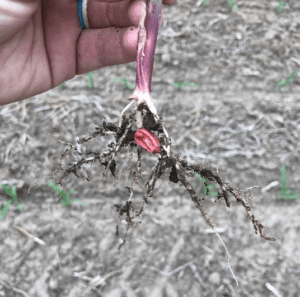 If planting standards are not held up throughout the season, we may also get areas of the field that look like the photos to the left or very similar results. Slotting or smearing of side walls and poor seed to soil contact result in inconsistent emergence and poor lateral root system development early in the season. Not only does that young crop suffer, but the effects of that decision to plant into unfit conditions will haunt that crop for the rest of the season.
If planting standards are not held up throughout the season, we may also get areas of the field that look like the photos to the left or very similar results. Slotting or smearing of side walls and poor seed to soil contact result in inconsistent emergence and poor lateral root system development early in the season. Not only does that young crop suffer, but the effects of that decision to plant into unfit conditions will haunt that crop for the rest of the season.
Typically, we can gain three to four thousand more ears per acre when we incorporate AgVenture planting standards and AgVenture seed quality. Here is what difference that ag math can make to an operation:
3, 500 ears gained x 8 bushel/thousand plants = 28 bpa
28 bpa x $7.50 = $210/acre
Across 1,000 acres that is the difference of $210,000 more revenue for that operation. Based on 1,000 acres of corn alone, it can be a staggering difference from operation to operation based on their standards and seed quality.
Always keep in mind the profitability of a strong stand of corn or soybeans and how many more bushels can be gained if it is pushed with the right yield enhancement tactics throughout the rest of the season.
